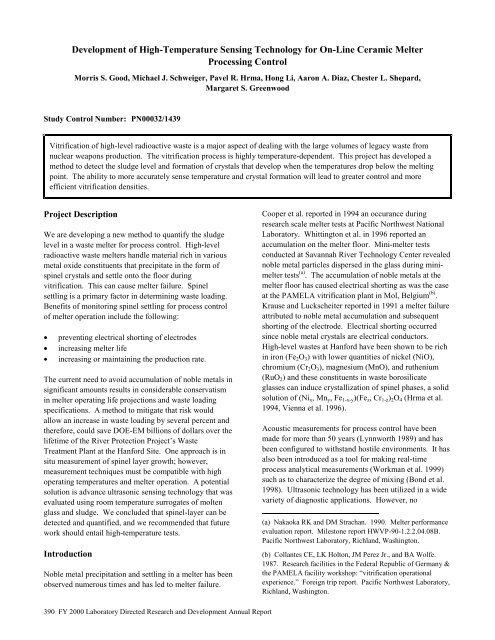PNNL-13501 - Pacific Northwest National Laboratory
PNNL-13501 - Pacific Northwest National Laboratory
PNNL-13501 - Pacific Northwest National Laboratory
Create successful ePaper yourself
Turn your PDF publications into a flip-book with our unique Google optimized e-Paper software.
Development of High-Temperature Sensing Technology for On-Line Ceramic Melter<br />
Processing Control<br />
Morris S. Good, Michael J. Schweiger, Pavel R. Hrma, Hong Li, Aaron A. Diaz, Chester L. Shepard,<br />
Margaret S. Greenwood<br />
Study Control Number: PN00032/1439<br />
Vitrification of high-level radioactive waste is a major aspect of dealing with the large volumes of legacy waste from<br />
nuclear weapons production. The vitrification process is highly temperature-dependent. This project has developed a<br />
method to detect the sludge level and formation of crystals that develop when the temperatures drop below the melting<br />
point. The ability to more accurately sense temperature and crystal formation will lead to greater control and more<br />
efficient vitrification densities.<br />
Project Description<br />
We are developing a new method to quantify the sludge<br />
level in a waste melter for process control. High-level<br />
radioactive waste melters handle material rich in various<br />
metal oxide constituents that precipitate in the form of<br />
spinel crystals and settle onto the floor during<br />
vitrification. This can cause melter failure. Spinel<br />
settling is a primary factor in determining waste loading.<br />
Benefits of monitoring spinel settling for process control<br />
of melter operation include the following:<br />
• preventing electrical shorting of electrodes<br />
• increasing melter life<br />
• increasing or maintaining the production rate.<br />
The current need to avoid accumulation of noble metals in<br />
significant amounts results in considerable conservatism<br />
in melter operating life projections and waste loading<br />
specifications. A method to mitigate that risk would<br />
allow an increase in waste loading by several percent and<br />
therefore, could save DOE-EM billions of dollars over the<br />
lifetime of the River Protection Project’s Waste<br />
Treatment Plant at the Hanford Site. One approach is in<br />
situ measurement of spinel layer growth; however,<br />
measurement techniques must be compatible with high<br />
operating temperatures and melter operation. A potential<br />
solution is advance ultrasonic sensing technology that was<br />
evaluated using room temperature surrogates of molten<br />
glass and sludge. We concluded that spinel-layer can be<br />
detected and quantified, and we recommended that future<br />
work should entail high-temperature tests.<br />
Introduction<br />
Noble metal precipitation and settling in a melter has been<br />
observed numerous times and has led to melter failure.<br />
390 FY 2000 <strong>Laboratory</strong> Directed Research and Development Annual Report<br />
Cooper et al. reported in 1994 an occurance during<br />
research scale melter tests at <strong>Pacific</strong> <strong>Northwest</strong> <strong>National</strong><br />
<strong>Laboratory</strong>. Whittington et al. in 1996 reported an<br />
accumulation on the melter floor. Mini-melter tests<br />
conducted at Savannah River Technology Center revealed<br />
noble metal particles dispersed in the glass during minimelter<br />
tests (a) . The accumulation of noble metals at the<br />
melter floor has caused electrical shorting as was the case<br />
at the PAMELA vitrification plant in Mol, Belgium (b) .<br />
Krause and Luckscheiter reported in 1991 a melter failure<br />
attributed to noble metal accumulation and subsequent<br />
shorting of the electrode. Electrical shorting occurred<br />
since noble metal crystals are electrical conductors.<br />
High-level wastes at Hanford have been shown to be rich<br />
in iron (Fe2O3) with lower quantities of nickel (NiO),<br />
chromium (Cr2O3), magnesium (MnO), and ruthenium<br />
(RuO2) and these constituents in waste borosilicate<br />
glasses can induce crystallization of spinel phases, a solid<br />
solution of (Nix, Mny, Fe1-x-y)(Fez, Cr1-z)2O4 (Hrma et al.<br />
1994, Vienna et al. 1996).<br />
Acoustic measurements for process control have been<br />
made for more than 50 years (Lynnworth 1989) and has<br />
been configured to withstand hostile environments. It has<br />
also been introduced as a tool for making real-time<br />
process analytical measurements (Workman et al. 1999)<br />
such as to characterize the degree of mixing (Bond et al.<br />
1998). Ultrasonic technology has been utilized in a wide<br />
variety of diagnostic applications. However, no<br />
(a) Nakaoka RK and DM Strachan. 1990. Melter performance<br />
evaluation report. Milestone report HWVP-90-1.2.2.04.08B.<br />
<strong>Pacific</strong> <strong>Northwest</strong> <strong>Laboratory</strong>, Richland, Washington.<br />
(b) Collantes CE, LK Holton, JM Perez Jr., and BA Wolfe.<br />
1987. Research facilities in the Federal Republic of Germany &<br />
the PAMELA facility workshop: “vitrification operational<br />
experience.” Foreign trip report. <strong>Pacific</strong> <strong>Northwest</strong> <strong>Laboratory</strong>,<br />
Richland, Washington.

















